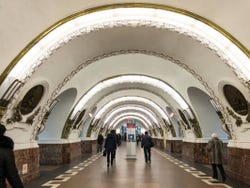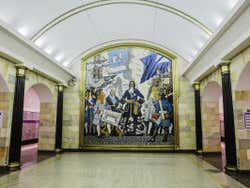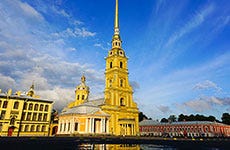
Saint Petersburg Metro
Convenient, efficient and beautiful: the St Petersburg Metro is not only a great way to get around the city, it's also a living museum of Soviet art and architecture.
A little bit of history
Plans to build the St Petersburg Metro began in 1899 - although not for lack of a number of inventors proposing the idea to the Tsar from 1820 onwards - but the outbreak of World War I followed by the 1917 Russian Revolution and then the Second World War seriously delayed construction.
Having suffered the impact of the events of early 20th century history in St Petersburg, the metro network was finally opened in 1955. Since then, it has continued expanding, currently having 5 lines (with 4 more planned) and 72 stations (126 planned), and it's the deepest metro network in the world, with Admiralteyskaya being the deepest station at over 280 feet (86 metres) below ground.
Operating times & frequency
The St Petersburg Metro operates every day of the week between 5:45 am and 12:30 am. Trains run about every 2 or 4 minutes, although frequency varies considerably depending on the line and time of day.
Ticket prices
A single ticket costs ₽ 60 (US$ 0.72): ask for "adin proyezd" and you will be given a "zheton" (token) to put in the machine. If you are going to use the metro several times during your trip, it's worth buying a Podorozhnik top up smart card which costs 60 RUB and works out at around ₽ 41 (US$ 0.49) per journey - plus you won't have to wait in line every time you want to use the metro.
The metro system has signs in English, and there are ticket machines in certain stations, so you should hopefully be able to communicate well enough to buy your tickets!
Metro lines
The St Petersburg metro covers a total length of 77 miles (124 km) divided into 72 stations. In each of our guides to the city's main monuments and attractions, we've included the most convenient metro station. The five different lines are like a living museum that tells the story of St Petersburg.
Line 1, inaugurated in 1955, is the oldest: its grand, elaborately decorated stations (particularly Avtovo and Narvskaya) are telling that it was planned during the Stalin era. Line 2 was only opened six years later, but you can see the shift in politics and ideology that had taken place in the meantime to functionality over beauty and decoration.
The rest of the metro lines follow a more modern and functional look, although a number of the more striking stations are home to curious decorations influenced by themes as varied as Communism, Ancient Greece and the sea.


